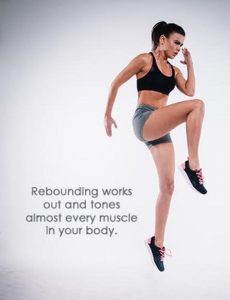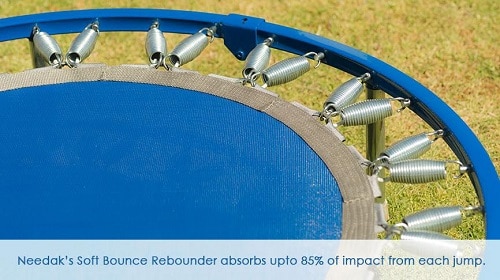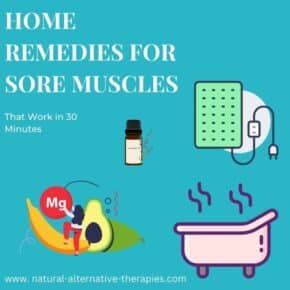
This is a guest post courtesy of Needak Rebounder for Natural Alternative Therapies.
But first, a few personal words:
I’ve been doing rebounding exercises ever since I’ve found out that NASA has declaired it as the “best exercise ever devised by man”.
And I’ve never looked back. Unlike other workouts I’ve tried, rebounding is actually fun.
But:
The health benefits of trampoline workout, also known as rebounding – are much more than fun.
Rebounding has many great health benefits — especially for your lymphatic system and your heart.
And:
It burns more calories than walking or running, while being 87% shock free (great for your joints).
In this post you’ll find the 5 most amazing health benefits of rebounding exercise, which will convince you to start jumping around and having fun while improving your health.
The Top 5 Health Benefits of Rebounding Exercise
Let’s start with the most unique health benefit of trampoline workouts:
1) Rebounding for Your Lymphatic System and Immunity
The lymphatic (“lymph”) system is a vital network of vessels which run throughout the body and is integral to our immune system.
One of the most significant functions of the lymph system is to help the body rid itself of toxins, waste materials and to filter out bad bacteria.
[yellowbox]It’s like a network of streams and rivers of liquid that collect unwanted material from cells in our body.[/yellowbox]An important concept to understand is that unlike the network of blood veins within our body, which are consistently flowing thanks to the pumping mechanism of the heart, the lymph system does not have a central organ to help the fluids within it to keep moving and circulating throughout the body.
This is where movement and exercise is crucial.
Muscular contractions from physical activity promote circulation of lymph fluids, and this is where rebounding is an especially effective form of exercise for lymphatic flow.
[yellowbox]The action of rebounding up and down causes vigorous movement of the lymphatic fluids, as though the lymph system was being given a good shake.[/yellowbox]Rebounding is considered by many natural health practitioners as one of the most effective ways of increasing lymphatic movement and therefore greatly assists your body in flushing out toxins and boosting immunity.
As little as 5 to 10 minutes of rebounding a day can effectively help your lymphatic system flow better and therefore help you feel better.
2) Rebounding Tones Almost All the Muscles in Your Body
 There are approximately 640 muscles in the average human body.
There are approximately 640 muscles in the average human body.
As we age, muscles lose their elasticity and firmness and therefore exercises that tone your muscles become an increasing important component of a healthy fitness regimen.
Jumping on a mini trampoline stimulates and activates almost every muscle in your body, making rebounding a highly effective way of keeping your body toned and strong.
From the fine muscles in your feet, to your larger leg muscles and all the muscles in your back, torso and arms that keep your balanced and upright, rebounding uses all of these as you bounce and coordinate your rebounding movements.
Many of us don’t have enough time to spend hours at the gym going from one machine to another in to workout all the different muscle groups – rebounding is a fantastic time saver that tones just about all of your muscles in the one exercise session.
Most importantly:
[yellowbox]Working out on a rebounder has way less impact on the joints, soft tissue and skeleton. Due to how a trampoline is made (using either springs or bungee bands), it absorbs much of the impact at every bounce.[/yellowbox]3) Rebounding for Heart Health and Endurance

Exercising on a rebounder gives your heart and lungs an impressive aerobic workout.
When you are rebounding, the large muscles in your legs are highly activated and in order to perform the rebounding movements these muscles need greater levels of oxygen.
The result:
Your heart and lungs have to work harder to ensure your muscles are getting all the oxygen fuel they need.
Regular rebounding conditions and strengthens your heart and lungs to work more effectively, building cardio endurance and better heart health.
4) Rebounding for Blood Circulation
Although your heart pumps blood throughout your body, many people in our modern age suffer from poor blood circulation due to sedentary lifestyles, desk jobs and insufficient levels of exercise.
Regular movement is integral for maintaining best blood flow.
As muscles move they contract and extend, creating a pumping action for the veins and capillaries nearby, forcing blood to circulate and making the task of circulation easier for your heart.
As we mentioned earlier, rebounding activates almost all of your muscles – which means all those muscles that are rhythmically and simultaneously contracting and extending as you jump up and down on a rebounder, are stimulating your entire cardiovascular system.
Blood flow increases tremendously when you rebound.
Increased blood flow not only means your body functions better at a cellular level:
It improves your mood, it increases mental clarity, it helps with Varicose Veins and any blood-circulation-related health conditions (and boy, there are many).
(See 10 more quick and easy to increase your blood circulation).
5) Rebounding for Weight Loss Via Intense Yet Low Impact Exercise
Low impact exercises involve performing movements that place less direct force on the body, often thanks to the use of a softer surface, specialized equipment or undertaking gentle movements.
Low impact means less shock experienced by the body, potentially reducing the risk of injury.
The most well-known low impact exercise is swimming – but not many of us have the time to visit the pool every day, nor to withstand the side effects of regular exposure to highly chlorinated swimming pool water.
Rebounding is a wonderful low impact exercise that can be performed any time, within the comfort of your home – to burn calories and lose weight (while having lots of fun)
But:
It’s important not to confuse low impact with low intensity.
Low intensity exercises do not elevate your heart rate. With rebounding you get the benefits of a low impact exercise, yet you can increase your workout intensity to your desired level.
So:
[yellowbox]If you want to do a high intensity fat burning workout, you can easily do so on a rebounder whilst still benefitting from the low impact nature of rebounding.[/yellowbox]Unlike running, which creates significant impact and shock on your joints, with rebounding you can get the same (or greater) level of exercise intensity as running – without risking your joints.
The soft surface of a good quality rebounder mat absorbs a significant amount of impact so that your joints don’t have to.
How to Choose the Best Rebounder
Look:
It is important to be aware that not all rebounders are of the same quality.
Low grade rebounders that are constructed using poor quality materials may not actually provide a low impact experience, and can be dangerous.
There are many rebounders on the market, many of which are manufactured in Asia cheaply, with little to no quality control.
Such rebounders can have a very stiff jumping experience and be a health hazard, causing more harm than good.
Choosing a rebounder from a reputable company (such as US-manufactured Needak – brings peace of mind for your wellbeing.
And when it comes to low impact, Needak produces their renowned Soft Bounce Rebounder – which absorbs up to 85% of the impact from every bounce.
About Needak
Needak Rebounder is an official retailer of the bestselling rebounder in the world. Their fitness device is focused on alternate forms of in-home cardiovascular health, and their blog features many articles which focus on this and how it relates to the sport of rebounding.
To your health and happiness,
Meital




